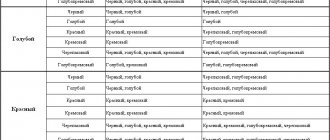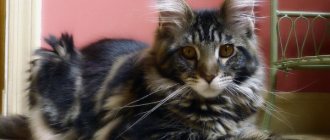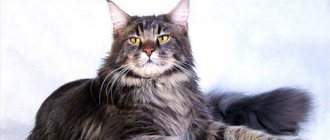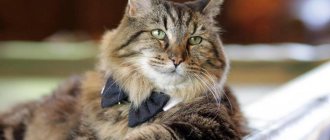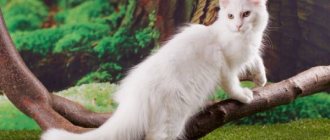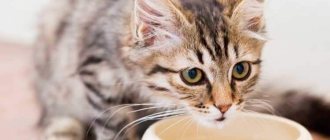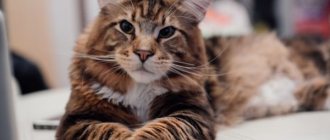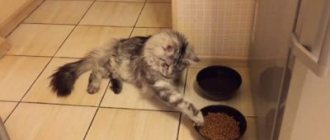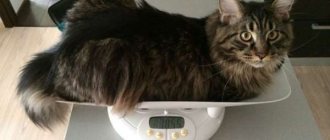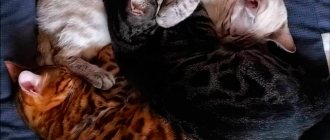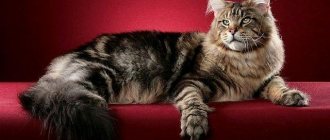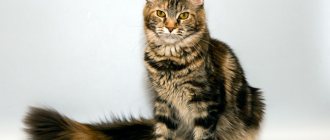Maintenance and care
Despite the fact that this breed of cat tolerates harsh climates well, the owner of large animals will need to pay a lot of attention to them.
The main nuance of maintenance is Maine Coon fur care. Since there is quite a lot of it, in addition, it stands out due to its length, in order to prevent tangles, the cat will need to be combed regularly. A suitable comb is a blunt-toothed comb. It is recommended to perform such procedures every other day. Long-haired breeds are also recommended to be bathed with shampoo once every 6 months. The animal's claws require attention. As they grow, the ends should be trimmed, avoiding removing the living part where the capillaries are located.
As a kitten grows, its teeth change, but caring for the animal’s oral cavity is mandatory at any time. For these purposes, use a special toothpaste and brush.
Hygiene measures will also apply to the ears. The ears are subject to regular inspection; if various types of dirt are found in them, they are cleaned with a damp cotton sponge. You should avoid using sticks or matches with cotton wool. Cats' eyes should be wiped with a damp swab using boiled water.
Big cats themselves are noted for their cleanliness, so they constantly lick their fur. To help your pet get rid of hairballs in the stomach, specialized pastes are sold for animals that help cleanse themselves from the inside. Neglecting such remedies can lead to constipation and coughing in your cat. In addition, Maine Coon owners are recommended to grow a “cat garden” at home, which will help them cleanse the body on their own.
Cats at any age will be interested in entertainment, in addition to spending time in the arms of the owner. For these purposes, it is worth installing scratching posts, labyrinths and ladders at home, as well as shelves, beds and other interesting devices designed for active pet play. Otherwise, the Maine Coon will use curtains, cabinets and sofas as “sports equipment”.
For cat litter, you can purchase special litter or sand, but cleaning the litter box should be regular in light of the large size and smell of feces of both Maine Coon boys and girls.
The issue of cat nutrition should be approached thoroughly. It is best to individually select dry food for your Maine Coon together with a veterinarian or breeder. However, the animal will also actively and correctly develop on natural food. Super class food will already contain the necessary vitamins for a member of the cat family. When choosing a different type of feeding, your pet’s diet should include raw and boiled beef, chicken, and turkey. You should avoid fatty meats.
The animal should also be given lean fish, dairy and fermented milk products, and boiled eggs. It will be possible to replenish the supply of essential microelements by including sprouted grains in the diet. Vegetables and cheese can also be given to pets. Your Maine Coon will need clean, fresh water. To select the optimal portions of food, you can use a special sign that will indicate the weight of the kitten and its approximate menu.
The optimal age for mating is one and a half years. Maine Coons typically have 1 to 6 kittens per litter per year. Cats have very developed maternal instincts, so they show amazing care for newborns. If the breeder for some reason does not want to breed cats, then castration is carried out for males. It is best to castrate an animal before the age of one year. Cats are sterilized.
Unrecognized
Chocolate, gold, and lilac colors are not allowed at specialized exhibitions. Coons with Siamese coat color are also not recognized. There are patterns that are considered unrecognized for the Coons. These can be called:
The coat color of Maine Coons is distinguished by a huge variety of colors and their combinations. The eyes of purebred animals must match the color of their fur. They can be blue (only pure white wool), green, yellow. White individuals may have different colored eyes (blue and green).
Raccoon cat color classes
The color of Maine Coons is distinguished depending on:
- coat color;
- the presence of patterns or their absence;
- the presence of various spots or their absence.
In order to make it easier to distinguish the appearance of a cat of different breeds, taking into account the color of its coat, as well as a number of other characteristics, about 20 years ago the fife Assembly created the first EMS code system. This system was gradually improved, and now it is considered traditional for judging cats in all felinological systems.
Maine Coons are designated by the first letters of the Latin name of the breed – MC (Maine Coon). Since their hair is considered semi-long, coons were included in the II category of purebred cats, and designated with the letters SLH - from the Latin language Semi Long Hair.
Regarding the fur of all mustachioed pets, felinological systems agreed that male cats can only be of two colors - red and black. Other colors are the result of lightening or oxidation of these primary colors. White wool is considered to be a lack of color. Felinologists have noticed that Maine Coon kittens born with a white coat have one or more dark spots on their heads, which subsequently disappear.
The designations used in EMS coding are the first letters of colors or even color genetics in various languages, mainly English and French. White shades and spots on Maine Coon fur, as well as various patterns, are usually designated with a special number.
Maine Coon color chart with codes
| Color code | Color |
| a | blue |
| b | brown, chestnut, chocolate, Havana |
| c | lilac, platinum, lavender |
| d | red |
| e | cream |
| f | tortoiseshell |
| g | creamy blue, tortoiseshell blue |
| h | brown tortoiseshell |
| j | lilac tortoiseshell |
| n | black, wild, sable |
| s | silver, smoke |
| w | white |
| 01 | van (white except for one or more spots on the head, tail or shoulder area) |
| 02 | harlequin (van with spots on the back) |
| 03 | bicolor, two colors |
| 04 | white markings |
| 09 | white spots 1-2 cm in size |
| 11 | shaded hair colors (1/4 part) |
| 12 | veiled hair colors (1/8 part) |
| 21 | stripes, agouti |
| 22 | marble color |
| 23 | brindle color |
| 24 | spotted color |
| 25 | ticked tabby |
So, for example, a Maine Coon with black smoke coloring will be designated as ns. Next, the number of the drawing will be added, if there is one.
Most often in Maine Coons you can find such combinations as n 22, ds 22, d 22, n 23.
Maine Coon d 22
Maine Coon n 22
Maine Coon ns 22
Maine Coon ds 22
Rare and expensive Mei Coon colors
If we consider rare and expensive colors in a broader sense, then we can say with certainty that such colors do not exist. The most expensive and rare color can be considered any color of an animal, which is included in the standards of both American and European systems. But a rather rare occurrence could be, for example, the birth of a kitten that is completely the same color, despite the fact that its parents have fur with some kind of pattern.
Color coding
The unified international EMS system allows you to figure out what color a Maine Coon is, according to which each color is assigned an individual code. Let's look at this in table form. In such a system, Maine Coons are supposed to have the following types of colors:
| N | black |
| A | blue (the result of oxidation of the black tint) |
| E | cream (ginger) |
| D | red |
| F | turtle (mostly females) |
| G | blue cream (the result of oxidation of tortoiseshell color) |
| S | smoky, silver |
| W | white |
If there are white spots on the skin, a digital code is added to the indicated letter code:
- if the animal is white with one or more spots of the primary color, then it is “honored” of the classification “van” - 01;
- if 2/3 of the individual is white, then it is a “harlequin” - 02;
- a two-color pet or bicolor is 03;
- with white (if it is less than half) – 04.
The presence and type of coat pattern allows us to distinguish the following types of raccoon cats:
- classic tabby or marbled (the animal has a pattern in the form of the letter “M” on the forehead or “butterflies” on the sides) – code 22;
- mackerel or tiger tabby (it can be recognized by the already mentioned letter “M” on the forehead, in addition, the animal has stripes similar to the color of a tiger’s skin throughout the body) – 23;
- spotted (so-called torn brindle or spotted) - 24;
- shaded (the manifestation of the tabby color on the silver coat, which makes it look blurry) -11;
- chinchilla – black series of colors, cameo – red series -12;
- agouti factor (it is obvious from the color that the individual is a tabby, but the pattern is difficult to attribute to a specific type) – 21.
Sometimes when describing an individual, characteristics of eye color can also be used. When accounting for it, special codes are also used:
- blue-eyed Maine Coons are coded as 61;
- cats with yellow, orange or golden eyes are code 62;
- in case of disagreement, indicate code 63;
- Green-eyed people have a code of 64.
You can learn about the colors of Maine Coons by watching the video.
How to care for an adult pet's fur
A healthy pet's coat should be silky, shiny and flowing. Her condition is affected by:
- proper nutrition, balanced in the amount of vitamins and minerals;
- conditions of detention. For example, a sedentary lifestyle, poorly ventilated rooms and regular stress negatively affect the appearance of the coat;
- proper care. Coons need to be combed 2-3 times a week with a special comb and bathed once every few months with shampoos carefully selected at the veterinary pharmacy. At the time of shedding (it can be seasonal, or associated with hormonal changes in the body of cats aged from 6 to 12 months), the pet must be combed daily.
Gold
This is the rarest and very beautiful color of cats with the coding ny 25. The background of the animals’ fur in this case is apricot, and the stripes on the hair are dark. The most common golden ticked color is found in British cats. According to the standard, the eyes of such pets should be emerald green. The paw pads, as well as the outline of animals in this group, are brown or black. The nose of cats of this color is brick-red.
Nutrition - what and how to feed?
Proper feeding of Maine Coons is an important part of a cat’s healthy life.
It is important to choose the right food and water dishes for your pet.
It is necessary to take into account the fact that in the wild, the ancestors of cats, before drinking, try to clear the surface of the water from debris, fallen leaves, and twigs. At the same time, water is sprayed in different directions. Pets have retained this reflex. The Maine Coon may even knock over a bowl of water or move it along the floor. Therefore, the drinking container should be moderately heavy or fixed to the floor so that it does not move and cannot tip over.
The food bowl should be kept away from the water container. Otherwise, splashes that get into the food bowl can ruin the food. If the cat stays at home without its owners for a long time, it is better to purchase a water bottle. Water should always be fresh and clean.
Feeding Maine Coons has its own rules:
- You only need to feed your cat dry food of premium quality. It contains the necessary vitamins and various nutritional supplements that are important for the health and normal development of Maine Coons. Can be combined with canned food;
- if you feed with natural food, then the basis of the diet (at least 80%) should be meat and dairy products, vegetables and grains;
- If the cat's diet consists exclusively of natural products, it is necessary to regularly give vitamins;
- with a mixed diet, dry food should be the basis, and natural food should be additional.
What natural products can you feed your Maine Coon:
- meat: poultry, beef (raw and cooked), rabbit, lean lamb, chicken livers and hearts.
- vegetables: carrots, beets, cabbage, cucumbers, zucchini, pumpkin, tomatoes;
- hard cheese;
- eggs: yolk once or twice a week, boiled or raw;
- boiled sea fish, seaweed and other seafood;
- cereals, bran;
- fermented milk products: cottage cheese, yogurt, kefir, fermented baked milk (milk can only be given to kittens under 3 months of age);
- cereals: three to four times a week as an addition to boiled meat;
- sprouted grains: wheat and oats.
Important! It is prohibited to add salt, sugar, or spices to cat food. It is strictly forbidden to give your pet beef and chicken bones, fatty pork, duck, goose, smoked meat products, sausages, sugar, potatoes, legumes, chocolate.
It is strictly forbidden to give your pet beef and chicken bones, fatty pork, duck, goose, smoked meat products, sausages, sugar, potatoes, legumes, and chocolate.
Cats need to eat fresh greens periodically. To prevent your pet from being drawn to dusty, dirty grass during a walk, you need to sow grass seeds (wheat, oats) in a low, wide container (box) at home and allow the cat to eat the young sprouts.
If a cat is allergic to any of the food or products, the allergen should be removed from the diet.
Cat food should not be hot or cold. It should be at room temperature. Kittens need to grind their food. The kitten should eat at least 5 times a day. This principle must be maintained for up to 2 months. From six months onwards, the frequency of feedings is reduced to three times a day, and eight-month-old cats should be switched to two meals a day.
Main characteristics
Tortoiseshell kittens appear quite rarely, as this is due to complex genetic processes occurring in the feline body. Typically, tortoiseshell color means mixing two, three or more colors on the fur of a cat. Speaking about the Maine Coon breed, we can safely note that in nature dozens of original combinations and variations of mixing colors on the fur of animals can be found, but, as a rule, spots of black and red shades can most often be found. You can also observe a “turtle on white”.
Let's look at the main types of tortoiseshell color.
Classical. The classic tortoiseshell color involves alternating orange (red) and brown shades on the animal's coat. If the parents of Maine Coons have very beautiful fur, and a chocolate shade predominates on it, then the kittens may also have a tortoiseshell color with chocolate and black spots.
Of course, these are just general ideas about the tortoiseshell colors of Maine Coons.
There may be other variations in the combination of shades and colors, but in general it is important to understand that tortoiseshell color implies the presence of spots of different sizes that smoothly blend into the fur of a cat or, in rare cases, a cat
Painted cats
The coat pattern often found among Maines is called tabby or, if pronounced in English, tabby. Scientists claim that tabby is present in the genotype of all cats without exception - they inherited it from their wild forest ancestors. The pattern is obtained due to the fact that, under the influence of a certain gene, the color of cat hair is zoned. Simply put, this means that the hair is not monochrome, but striped, as can be seen upon closer inspection.
Depending on how the light and dark areas are located on an individual hair, one or another pattern is formed on the wool. Tabby is divided into various "patterns", for example:
- brindle color is continuous parallel stripes;
- spotted – intermittent stripes;
- classic - marble stains.
The latter looks best on a black Maine Coon; the black tabby Maine looks surprisingly noble.
Elegant ticking
A type of pattern that is uncharacteristic for Maines is ticked. With this color, the entire mass of the coat consists of striped (ticked) hair in the absence of a pronounced pattern (its residual signs can be on the legs, chest and forehead). Ticking is more common among Abyssinian cats; Maine Coons with this color are very rare. These cats look very elegant, especially the black ticked one.
The charm of diversity
Tortoiseshell color is a good omen - many believe that multi-colored cats bring their owners good luck in all endeavors. This may not be true, but they definitely bring joy and aesthetic pleasure.
The pied Maine Coon, especially with “smoke”, is incredibly picturesque
And in this case, it is not so important whether it is a classic “tortoiseshell” (randomly scattered spots of any color except white), or spotted brown, reminiscent of autumn foliage in color, or creamy blue tortoiseshell, combining delicate pastel shades. Without exception, all the “turtles” are magnificent!
The most common breeds that produce tortoiseshell kittens
An unusual tricolor color is found among representatives of some breeds:
- Persians;
- Siberian;
- Maine Coons;
- bobtails, regardless of subspecies;
- Turkish Angora;
- Cornish Rex;
- orientals;
- Scots;
- Norwegian forest cats;
- sphinxes;
- British.
Each of these breeds has its own characteristics of tortoiseshell color:
Scottish and British - these breeds have a tortoiseshell color that is recognized as an international standard. But this does not give them an advantage. As practice shows, in most cases experts do not particularly favor representatives of these breeds with a bizarre coat color, and the likelihood that the animal will win at the exhibition is extremely low. But with the acquisition of these cats, on the contrary, it is a completely different story. British or Scottish tortoiseshells with this coat color are bought much more willingly, because cuter creatures simply cannot be found.
Cornish Rex. Representatives of this breed are endowed by nature with such an unusual coat structure that any color on it will look truly amazing, and tortoiseshell color even more so. In combination with the unique grace and natural aristocracy that is felt in every movement of the cat, the tortoiseshell color adds even more impressiveness, classifying the animal as one of the world of “bohemia.” According to the breed standard, the color of their coat should not combine many shades, but tricolor is very welcome among experts.
Bobtails. Regardless of the subspecies of the breed, the tortoiseshell color is recognized as a standard and is very welcome in individuals. However, these animals are popular not only due to their often unusual coat color. Bobtails are distinguished by high intellectual abilities and sociability. Unlike most cats, tortoiseshell bobtails are the best and easiest to train.
Turkish Angora. It is commonly believed that these cats should be pure white as snow and have heterochromia (different colored eyes), however this is not entirely true. Among Turkish Angora cats, tortoiseshell coat colors are often found, which are of great value.
Maine Coons
These cats attract everyone's attention with their large size and powerful torso. Impressive dimensions, proud, independent look and originality of character against the background of tortoiseshell color make Maine Coons especially attractive to cat lovers and even a little mysterious.
Sphinxes
Surprisingly, but true: a breed such as the Sphynx, characterized by a complete absence of hair, can have a tortoiseshell color on its bare skin. Despite the non-standard appearance, the unusual lack of fur, “naked” individuals have recently become increasingly popular. The reason is the incredibly flexible, easy-going nature of the animals, their friendliness and affection towards the owner and all household members.
Orientals. If in other breeds experts disdain tortoiseshell colors, although this is allowed by the standard, then in Orientals this color is only welcome. The breed standard allows for mixing 4 colors. These cats are incredibly smart, wise in an oriental way and, despite their outward independence and independence, they really love communication with people and even need it.
Persians, exotics. These breeds occupy a leading position in choice as pets. Tortoiseshell color is not common among them, but it cannot be called rare either. Such an unusual combination of colors on long fur makes cats incredibly beautiful and attractive.
Norwegian. Among all the breeds, it is generally accepted that the Norwegian Forest cat in this color looks the best. Thanks to the thick and long coat, the color transitions and intricate lines formed by them look especially elegant and unique.
Outbred murki.
Tortoiseshell colors are also found among yard cats.
Superstitions and signs associated with tortoiseshell cats
Not every calico cat is a tortoiseshell, but every tortoiseshell is always a calico cat. It is the combination of three colors in color that gives such a cat the mystical properties of a living amulet. After all, each of the colors has its own meaning:
- white color symbolizes purity;
- black color neutralizes negativity;
- The red color attracts wealth and good luck.
The unusual and unique color of the tricolor at different times impressed different peoples so much that the “tricolors” managed to acquire a fair amount of myths and legends, signs and superstitions. Which of them can be completely ignored, and which are still worth paying attention to - judge for yourself.
It is no coincidence that many signs, superstitions, and even mystics are associated with tricolor cats.
For example, many wedding signs are associated with these cats. If such a “turtle” accidentally wandered into your yard, there will be a wedding soon, even if it has not yet been planned. Under no circumstances should you chase away a calico cat that has come to you - in this way you drive away good luck.
In England
Rational Englishmen are superstitious, but practical - they understand: everything in this life costs money. Therefore, they will never accept a tricolor cat as a gift just like that - they will definitely give at least some small change to the donor for it. And if the tortoiseshell kitten itself came to the house, then you are supposed to pay for happiness in the following way: leave three silver coins, no matter what denomination, at the crossroads.
The British know: you have to pay for happiness
British and Scottish cats are the national pride of England. The British are happy to have them in their homes - and the tricolor color is very popular. English sailors tried to take calico cats with them on long journeys: for protection not only from rodents, but also from storms, and even from... attacks by pirates.
In Russia
Probably everyone in Russia knows: a tricolor cat brings happiness to the house . Such cats have long been called rich and welcomed in every possible way. In Rus', cats have always been considered the helpers of the brownie - but help from them in good deeds should only be expected in cases where the color of the owner’s hair and the cat’s fur matched. In this sense, the tortoiseshell color was a win-win, since it contained a spot for any human “suit.”
The main assistant of the brownie would be the legendary cat Bayun: he took care of small children, scared away all sorts of evil spirits from the house and did a lot of other things useful for people. However, judging by the descriptions of this magical beast, he was still a cat, and not a cat - too many colors were combined in his fur.
Meet Bayun the cat, the brownie's deputy
Among the most common Russian signs associated with the tricolor cat are the following:
- the cat washes itself - expect guests;
- the cat is stretching in your direction - you will receive a gift or new thing;
- the cat sleeps curled up in a ball or licks itself against the grain - there will be bad weather.
IN THE USA
Americans call “turtles” money cats - according to many owners, it was after the appearance of the three-colored cat that unexpected wealth appeared out of nowhere and success in business came. Therefore, in the USA, as well as in many other countries, it is customary to be the first to introduce a fluffy tricolor into a new home - it will definitely bring prosperity with it.
Of the American-bred breeds, bobtails are most often tricolored. This is still a very rare breed and is highly valued in its historical homeland. American Bobtails are real heroes: they have an athletic build and look like real defenders. And such a three-haired warrior cat will definitely be able to protect his owners from all troubles.
In Japan
The Japanese place figurines of tricolor cats at the entrance to their homes. Then happiness, wealth and harmony will come to the house, hand in hand. These can be any images, but maneki-neko figurines, a purely Japanese know-how, have gained the greatest popularity all over the world. Maneki-neko most often depicts a white cat with black and red spots - waving its front paw invitingly, the talisman lures good luck in all its manifestations into the house.
The maneki-neko mascot has become popular all over the world.
Live tricolor cats of “our own production” are also very popular in the Land of the Rising Sun, primarily Japanese bobtails. These bob-tailed cuties become favorite amulets in many homes.
The Japanese Bobtail is everyone's favorite in the Land of the Rising Sun
In Arab countries
Muslims revere cats much more than dogs, and they consider tricolor cats to be very important amulets. After all, if you believe the ancient Arabic legends, it is these cats that reliably protect the house from fire and other misfortunes.
The most popular Maine Coon colors
Maine Coons have two basic colors – red and black. The remaining colors appeared as variations of the original color scheme. White is not a base shade, but indicates that there is simply no pigmentation.
Cats of this breed have a large range of colors classified, which allows you to specifically and briefly describe the appearance of the animal.
Red marble
The pattern on the fur of ginger cats is spiral-shaped, and the pattern is several tones lighter than the main hair coat.
Marbleds are classified as the classic tabby variety. Red marble
Black marble
The pattern is located in the same way as in red marble. The only difference is that the pattern is arranged in black patterns on brown wool.
Solid
Solid is characterized by a uniform coat color. Pigmentation is obtained by recessing the gene responsible for the tabby color. As a result, makecoons have a chic, monochromatic coat with subtle stripes, which can be seen in representatives with blue or beige coat.
The following types of solid are distinguished:
- Black
- White
- Red
- Blue
- Beige
Solid
Smoky
Smoke coloring is characterized by uneven pigmentation of the hair.
The root area is white, or several shades lighter than the upper part of the hair. As the cat moves, the light tone becomes more noticeable, highlighting the beauty of the pet.
- Blue
- Black
- Red
- Tortoiseshell
Smoky
In addition to these colors, there are divisions according to the length of colored hair:
- Chinchilla – 1/8 of the hair is dyed
- Shaded - 1/4 of the hair is colored
- Smoky – 1/2 part of the hairline.
Only the top part of the hair is brightly pigmented. The beauty of the smoky color is conveyed during any movements of the Maine Coon.
Tortoiseshell
All over the cat's body there are randomly located spots of red, black, white and brown.
Tortoiseshell color is more common in females. This is due to the attachment of the tortoiseshell color gene to the X chromosome. Tortoiseshell
Tabby
Maine Coon striped color. With this coloring, each hair is unevenly colored in different colors and shades, creating an intricate striped pattern on the pet’s fur. Common Maine Coon color scheme.
It is assumed that “tabby” is characteristic of wild cats and is the original coloring of the first domesticated purrs.
- Brindle – stripes are located vertically throughout the cat’s body.
- Classic – marble colors.
- Spotted - intermittent stripes on the coat, forming longitudinal or thin oval spots.
- Ticked - stripes are present only on the face. Among Maine Coons it is considered a rarity and is a defect, since it is not recognized as a breed.
Tabby
Silver
Silver color refers to marble colors. The Maine Coon's light gray coat is coated with a marbled spiral pattern with black pigment.
White
Refers to solids.
A rare color for Maine Coons. Pure white cats without patterns or spots. Animals of a given color do not exhibit any pattern arrangement, regardless of viewing angle.
White
Calico
White cats with bright red and black spots on the body. The spots are outlined and stand out against a white background.
A distinctive feature of calicos from turtles is that when calicos are painted, the spots are located on a white background, while in turtles they are on a black background.
Calico
Color designation
The letter part is the definition of the base color on the animal’s coat. Placed at the beginning of the encoding.
| W | white |
| N | black |
| D | red |
| A | blue |
| E | cream |
| F | tortoiseshell |
| G | blue-cream tortoiseshell. Appeared as a result of discoloration of the classic tortoiseshell color. |
The digital part is the designation of the pattern on the Maine Coon's coat. The arrangement of white spots begins from scratch:
| 01 | predominantly white with colored spots on the head, tail and shoulder area. |
| 02 | white with spots on head, tail, shoulders and spine. |
| 03 | 1/2 wool is white. |
| 09 | white spots on the limbs or chest. |
Tabby drawings:
| 22 | brindle |
| 23 | marble or classic |
| 24 | spotted |
| 25 | ticked |
Maine Coon eye color is rarely marked, since breed standards allow for free coloring of the iris.
Knowing the markings of colors and colors according to the table allows you to choose a Maine Coon kitten without looking at its photographs. At the same time, the future owner of the animal will know what color the animal will come to him, which makes it easier to choose a pet outside of his locality.
Table and color codes
Help in determining the Maine Coon's color is the international EMS system. In accordance with it, each color of the breed has an individual code, which consists of letters and numbers.
If there are spots on the cat's fur, a digital code is added to the letter:
- 01 – white Maine Coon with one or more spots of the main color (aka “van”);
- 02 – two thirds of the wool is colored light (aka “harlequin”);
- 03 – bicolor;
- 04 – there is a light color in the cat’s fur, but less than half of it;
- 09 – white marks no more than 2 centimeters in size;
- 11 – unexpressed color, as if covered with a haze and shown on gray fur, the so-called “shaded tabby” (no more than 25% of the main color of the cat’s fur);
- 12 – chinchilla (dark color) or cameo (red color);
- 21 – “agouti” (Maine Coon has a tabby color, but the pattern is difficult to classify);
- 22 – typical tabby or merle (letter “M” on the forehead or “butterflies” on the sides of the cat);
- 23 – tiger tabby or mackerel (the letter “M” on the cat’s forehead, the stripes on the body are arranged in the manner of a tiger’s);
- 24 – spotted or broken brindle;
- 25 – ticked tabby.
A special coding is also used for the color of the breed’s iris:
- 61 – Maine Coon with blue eyes;
- 62 – Maine Coon with orange, yellow or golden eyes;
- 63 – heterochromia;
- 64 – Maine Coon with green eyes.
If the documents indicate N22 or D22, this means that the Maine Coon is black or red with a marbled color scheme.
Another important table shows the likely color of the offspring.
The Maine Coon coat itself can have different color combinations. And there are so many variations of drawings of a cat of this breed that it is impossible to count. And this diversity was increased even more thanks to the painstaking work of breeders. Therefore, every fan of the breed will definitely be able to find a cat in accordance with their own preferences.
I like1I don't like
Care and health depending on color
The most dangerous color in terms of cat's health is considered to be white coat color, which can give the Maine Coon not only charm, but also congenital deafness. By the way, Darwin once pointed out the connection between blue eyes, white color and deafness.
To minimize the risk of such an anomaly, many felinological organizations prohibit mating between two snow-white sires.
To avoid purchasing a deaf animal, you should not buy it through free classified sites or from dubious breeders. Remember that white kittens may have blurry markings on their faces; these usually go away with age.
It is better to wash white wool with special shampoos (for light-colored animals) and not to use conditioners that can give it an unnatural shade.
Owners of black Maine Coons face another type of difficulty - browning and graying of the coat. This usually happens before seasonal molting or, conversely, after a coat change. If your cat does not show off at shows, a change in shade is not fatal.
A Maine Coon vying for the championship title must be flawless - without a “collar” and “pants” that are gray or brown. Proper nutrition, as well as bathing and combing, which stimulate the removal of brown/gray hairs and the active growth of new ones, which eventually acquire a charcoal color, will help get rid of the unwanted shade.
Tabby
This type of coloring is present in all representatives of the Maine Coon breed, but may not be expressed in a bright form. This color is a genetic predisposition. A cat's hair has its own zoning or striping. The wild ancestors were tabbies, which was inherited by modern representatives. There are various options for this design.
Classic, spotted and brindle tabby
Characterized by wide stripes of a spiral shape. They are usually located on the sides of the animal, and can resemble marble stains. Spotted tabbies have intermittent stripes or spots of color throughout the animal's body. The brindle tabby is similar to the brindle coloring - vertical stripes along the entire length of the body.
Ticked Tabby
These cats have no stripes or spots at all. The fur has a peculiar pattern on the face, paws, and chest. Ticking is the distribution of pigment along the hair. The tip has a rich shade, gradually losing brightness towards its root.
What colors are considered the most expensive and respectable?
The fashion for the color of cats changes over the years. Either red marble soars in price, or Harlequin. Colors can be truly rare and original. But the value of animals is not in them, but in their health and breed characteristics.
A cat is a friend, a family member. It doesn't matter what his fur is. They choose a friend with their hearts and for a long time, and the colors are all good in their own way.
Cheaply choose and acquire a friend in the Lakiss nursery, Novosibirsk. For example, a black marble male kitten costs 5,000 rubles.*
Kittens are delivered to any city in Russia and abroad by the AKBARS nursery in the city of Ufa. They are purebred with passports and pedigree. The average price is 15 thousand rubles.
Random color combination
Sometimes there are situations when the maine has a color that does not fit any of the color types. For this purpose, its own classification was created. These colors can be called:
- Brown tabby with spots. Such an animal has spots of red and brown.
- Blue spotted tabby. The cat in this case has cream and blue stripes on its body.
- Creamy blue. The spots are scattered in a chaotic manner throughout the body. This color is sometimes called a blue turtle.
- Creamy blue, white.
- Spotted tabby with white spots. The color is similar to the previous one, but there are inclusions of white spots.
Such combinations are also rare.
White spots
Bright white markings are in addition to the main color. The Maine Coon's spots are distributed depending on many factors. In documents of origin it is customary to write down as follows:
- Van – a large amount of white, colored color on the head and tail (van);
- White buttons are small spots (buttons);
- Harlequin – large colored spots against a white background (harlequin);
- Locket – a white spot on the chest of a Maine Coon (locket);
- Bicolor – white and color 50/50 (bi-color);
- Gloves - the ends of the paws are white (mitted).
If a Coon has white markings on his paws and chest, then he has a tuxedo. There is no official definition of this, but many people use it. Spots can also be found on the head of a Maine Coon.
Types of colors and their descriptions
Based on the basic colors of Maine Coons, breeders have developed many new colors of the breed. The most valuable of them are single-color variations and covers with a clearly defined pattern or spots.
Tabby
Tabby is a color with stripes. There are additional features:
- The presence of stripes of medium thickness on the muzzle, which outline the eyes and appear in the letter “M” on the cat’s forehead.
- Each hair itself is striped. Light and dark alternate with each other along the entire length. This phenomenon is called "agouti".
The Maine Coon tabby color exists in several subspecies:
- classic;
- brindle;
- ticked;
- spotted
Regardless of the type of tabby pattern, it can be anything that the breed allows. But agouti ranges from light blue to bright red.
Solid
Solid is a monochromatic color. It appeared due to the suppression by breeders of the gene that is responsible for the appearance of the pattern on the coat of a cat of this breed. Respectable Maine Coons do not have obvious stripes or tan marks. But this does not mean that the cat is not a carrier of a recessive gene. Therefore, monochromatic parents may well have tabby-colored kittens.
Solid color comes in the following options:
- black;
- blue;
- red;
- white;
- cream.
A Maine Coon with a black solid color is quite a rare occurrence. Black solid kittens may have subtle stripes, but as they grow, they are completely hidden behind the monochrome.
Solid Blue Maine Coons have no visible stripes and have a beautiful gray coat. Blue Maine Coons often have piercing green eyes.
The red Maine Coon is also somewhat of a rarity. Red shades are typical for most cats, but it is quite difficult to hide the presence of stripes with such pigmentation. Therefore, finding a monochrome ginger cat is quite difficult. Solid light and cream Maine Coons are even rarer.
Tortoiseshell
Tortoiseshell color means that the cat's coat has one predominant color, which is decorated with spots of a contrasting shade. They are located throughout the body in a chaotic manner.
Tortoiseshell colors come in:
- Sitseva. On the fur, markings in the form of patches of basic colors prevail, sometimes white ones are also found, then the color is called “tortoiseshell with white”.
- Pictured. The spots contain a pattern in the form of stripes or stains.
- Scaly. Red and black markings alternate like scales.
- Solid. The spots of basic shades are large in area and stand out with clear boundaries.
Smoky (silver) color
All smoky Maine Coons are united by the obligatory presence of a black or blue “collar”, the tips of the hair of which are painted white.
Depending on the color intensity, the following subspecies of smoky colored cats are distinguished:
- chinchilla (only the tips of the hairs are colored);
- shaded smoke (hairs are colored exactly a quarter);
- black smoke or blue smoke (white color is only at the base of the hair);
- true smoke (hairs are exactly half colored);
- silver (the hair is white at the base and silver at the tip);
- cream (kittens of this breed are born with brilliant white fur, but become cream as they grow older).
Color with white spots
Maine Coon with white spots is another result of the efforts of breeders. This color appeared because many people thought the coloring was spectacular, and the previously missing white markings were considered a defect in the breed.
The main thing for a color with white spots is the clarity of the boundaries. Color variations do not depend on the intensity of the color, but on the number and method of distribution of specks:
- “gloves” (only the bottom of the paws is white);
- van (white color predominates, but the head and tail remain colored);
- “medallion” (white mark on the chest);
- “buttons” (one or more randomly located spots);
- bicolor (white markings are combined with another color in a 1:1 ratio);
- harlequin (a white cat with several large colored markings);
- “tuxedo” (“gloves” and “medallion” are combined with a dark color on the back).
Features and health
In kittens with white fur, deafness can be suspected from the first days of life. This statement is not always true, but a Coon with white spots in the area or on the ears is highly likely to have hearing problems. There is a rule that should be followed to avoid unpleasant results. It is not recommended to cover white cats with white cats. It's better to choose another partner. By the way, in white kittens, one of the parents must have the same color or both.
Since the Maine Coon is a generally healthy breed, the color of the coat does not determine other characteristics of the body. Kittens with bleached or white coats have thinner hair. An adult coon with a similar coloration will have a similar coat structure.
Solid color – for respectable cats
Solid colors without patterns (or with weakly expressed “shadow” patterns) are called solids. One of the rarest is the completely red Maine Coon, scientifically speaking - the red solid.
color red solid color red solid color red solid
At the same time, shades of red are found very often among coons, and the red Maine Coon kitten is perhaps the most common offer on the “cat” market. The point here is that on red wool the pattern appears brighter than on any other, and in this case it is practically impossible to get rid of the residual tabby.
However, this is not a problem; stripes and spots do not spoil the red maines at all. The red marbled Maine Coon is especially beautiful. This color is characterized by smooth transitions from red to almost brown, creating a unique effect of color play.
color red merle color red merle
color red marbled with white (bicolor)
Mystical black
Black cats always attract attention. And a Maine Coon with a solid black color is something special. A chic, graceful panther in a black silk fur coat and a “wild” look! However, this luxury requires special care. Black color in the cat world is a complex phenomenon. It’s like a veil thrown over the usual stripes. Therefore, in kittens with this color, up to a certain age, a pattern is visible, the so-called “residual tabby”. Then the skin begins to bloom and the cat appears in all its dark beauty.
But stripes and spots tend to pop out from under the veil if not properly cared for or fed! Black cats participating in exhibitions and preserving the deep black color of their fur are forced to follow a special diet (the food should never contain beets!), and also avoid direct sunlight. From all this, black wool can acquire an uneven brown tint.
color black solid color black solid
color black solid
Blue like the sky
Blue maines deserve special mention, which are not yet very widespread in our country, but in the West they have long won universal love and admiration. In Russia, it is rare to hear even the correct name for the color - usually a blue Maine Coon is simply called gray, although this rich and beautiful color can hardly be called that. There are many variations of blue coloring, and it is difficult to choose - the blue solid Maine Coon is simply delightful, but the blue marble looks, perhaps, even more interesting. However, the greatest delight is caused by the Maine Coon of the “blue smoke” color - when moving, such a cat shimmers with the richest shades, from graphite gray to pearlescent.
color blue solid
color blue solid color blue solid
What is the danger of white people?
Maines in light shades also look luxurious. But caution must be exercised here. White coat color may indicate some genetic abnormalities. In particular, the white coon may be deaf. To be on the safe side, you should probably switch to a cream Maine Coon - cats of this color are no less pleasing to the eye. On the other hand, a cat with any disabilities can become the most beloved!
color white solid color white solid color white solid
Tortoiseshell
The tortoiseshell Maine Coon comes in two types – torby and torty.
The first type is a combination of red and black shades of wool, expressed in a dark brown color. The torti has a greater addition of red with dark cream. Of particular interest is the fact that tortoiseshell coloring is most often found in cats. The probability of a male being born with this coloring is approximately 1 in 1000.
On such cats, markings of different sizes and shapes are more clearly visible. Based on the severity of these spots, several colors can be distinguished:
- calico;
- flap;
- chintz.
These cats are characterized by the presence of red shades of fur. The classic color, consisting of three colors, is obtained by mixing black and red. This makes the coat more variegated. There are also several tortoiseshell shades.
Scaly tortoiseshell
Reminiscent of fish scales, the order of spots on the body is checkerboard. These spots alternate in black and red tones and are unevenly distributed. Any one of the colors may predominate.
Calico and solid tortoiseshell (patchwork)
The spots of black and red color resemble flaps. They have defined boundaries and can overlap each other. If the wool has white patches, this color is called “tortoiseshell white” or calico. Red and black spots are solid in color and clearly visible on the animal’s body.
Blue wool
Such cats, belonging to group a 25, have fur of a warm beige background with blue ticking. The nose and eyes of these animals are outlined with a grayish rim. The paw pads of blue cats are deep pink. The nose is the color of a withered rose. These cats have yellow eyes.
